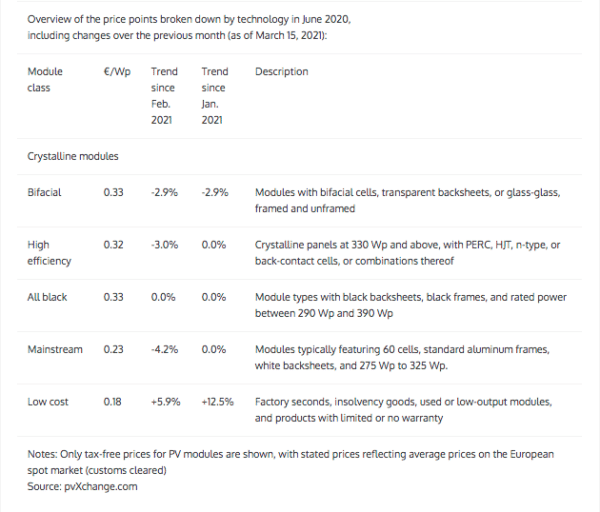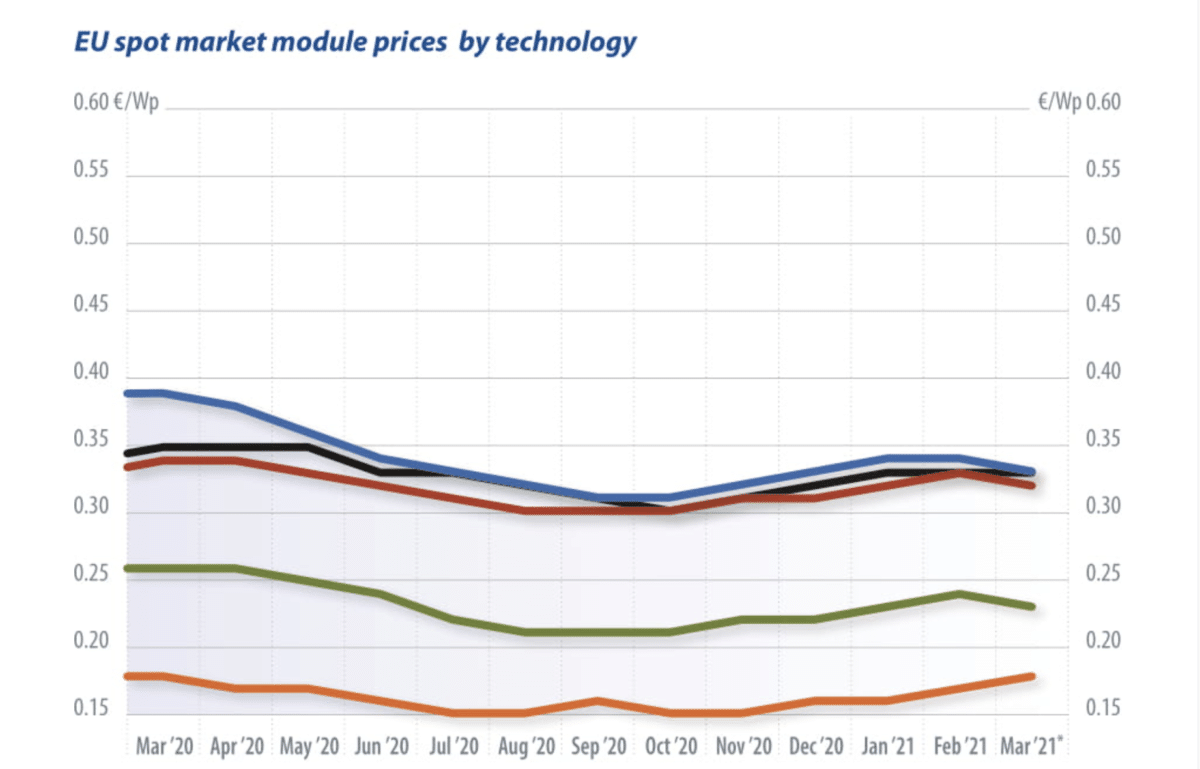From pv magazine 04/2021
In recent weeks, module prices have stabilised at a high level across most technologies, but availability to fill short-term demand remains poor. At present, almost no modules are available for below $0.20/W, even for larger projects. New deliveries of significant quantities from Asia are expected in the April-June timeframe, but even those are likely to be in the high-efficiency sector and thus the high-end price range. So far, no manufacturers have signalled that prices will come down significantly in the second half of the year.
The high cost of raw materials continues to put pressure on module prices. Many prefer not to commit to any more binding prices to avoid another train wreck like at the beginning of this year, when they could only honour agreed contract prices by foregoing any profit. Delivery volumes to Europe were quickly capped as the focus shifted to more lucrative markets. Now, some are waiting to see how demand in China shapes up before writing delivery schedules and price lists.
In Europe, it will be interesting to see whether the current high demand for modules, driven by the German market with up to 500 MW per month, will slow after the latest FIT deadline. The transition period runs until March 31, by which time rooftop systems up to 750 kW must be operational to qualify for the full FIT. Demand from April onwards will largely depend on how quickly the players adapt to new conditions and whether the small-scale sector in Germany, which is already booming, can compensate for the loss of volume in the medium-scale segment.
Size and weight
Over the past 12 months, PV panels have become larger and heavier thanks to larger wafer dimensions. In my view, there is one main reason driving this: to make production more efficient, and thus less expensive. Especially in times of scarce resources and high raw material prices, this seems the only way for manufacturers to make a profit without their cell and module prices rising excessively. But for planners, installers, and dealers, this creates new, sometimes intractable challenges.
A larger cell area also invariably entails a higher output amperage. Although cells are first cut in half or even smaller, operating currents of 12, 13 or even 18 amps are no longer a rarity. This poses a challenge in finding a way to connect strings that are compatible with the intended inverter. Often, new modules have such a high max current that two parallel strings can no longer be connected to a single input, which makes efficient utilisation of the inverter difficult.
Neither their size nor weight of modules larger than 2m² allows single-person handling adhering to occupational health and safety measures. Products for ground mount applications, which recently have reached power ratings north of 550 W, leave mechanical handling as the only option. These products can only be safely installed with a suction lifter and robotic arm – provided there is no strong wind.
Packing density and pallet weight is another topic that has received far too little attention. Increasing the glass area invariably increases the unit weight, especially in the case of glass-glass modules. At the same time, however, the frames are thinner – in the worst case, at the expense of stability. A pallet containing 31 modules at 32 kg weighs in at more than 1,000 kg. Freight forwarders like to apply surcharges to such loads, which makes transport even more expensive. Usually module crates are stacked two high in the truck or container, and then have to be unloaded and moved to a temporary storage facility – or worse, to a construction site. This is no longer possible with a pallet truck, hydraulic lift or other light equipment; heavy equipment must be available.
For rooftop modules, further optimisation is needed to ensure trouble-free installation, ideally by a single person. A module area of 2m² should be the upper limit in any case, which is true with the current cell efficiencies for module types up to 400 W. If we move from the flat roof to the pitched roof segment, especially for small systems, aspects such as aesthetics and service life come into play. Black framed, or even glass-glass modules are a good choice. Since an individual weight of 25 kg should not be exceeded, the modules should have an output of up to 350 W. For smaller roofs on detached or terraced housing, panels in the classic 48- or 54-cell format – for example, measuring 1.5 x 1 meters at 300 W – are an option. This is because, as modules get larger, limited clamping area makes it increasingly difficult to design a sound substructure.
The ideal ground-mount module may be somewhat larger. For ease of processing, however, 2.5 m² and 30 kg should be the upper limit – a format of 2.3 x 1.1 meters and 550 W, for instance – at least for a mostly manual installation. On the shipping side, packing densities of 24 to 26 modules per pallet have a long and proven track record. Modules can also be transported upright – on a euro pallet or an industrial pallet, for instance. This enables efficient loading, but the individual weight should be kept below 900 kg. An option to remove individual modules without the package collapsing rounds off my wish list.
I reach these recommendations on the basis of the above mentioned criteria, all of which seem important to me. In the hopes of stimulating a long overdue discussion on these issues, I welcome other opinions.

This content is protected by copyright and may not be reused. If you want to cooperate with us and would like to reuse some of our content, please contact: editors@pv-magazine.com.









By submitting this form you agree to pv magazine using your data for the purposes of publishing your comment.
Your personal data will only be disclosed or otherwise transmitted to third parties for the purposes of spam filtering or if this is necessary for technical maintenance of the website. Any other transfer to third parties will not take place unless this is justified on the basis of applicable data protection regulations or if pv magazine is legally obliged to do so.
You may revoke this consent at any time with effect for the future, in which case your personal data will be deleted immediately. Otherwise, your data will be deleted if pv magazine has processed your request or the purpose of data storage is fulfilled.
Further information on data privacy can be found in our Data Protection Policy.